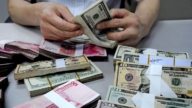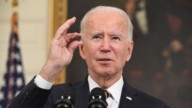【新唐人2013年06月24日讯】6月以来,大陆金融业爆发了历年来最严重的“钱荒”,各大银行因为流动资金出现严重短缺,不得不互相借钱,银行间拆借利率飙升到历史新高,但资金依然有价无市。地方政府债台高垒,偿还无期。而今年,世界媒体纷纷聚集中国金融市场,国内外金融、理财专家、经济学家、财经作家相继论断“中国金融危机正在全面爆发”。
6月23号上午,上海、北京、武汉等多个地方的工商银行系统柜面取款、ATM、网银等都被告知出现故障,无法取钱,虽然官方声称是电脑系统升级原因造成的,但网民多数质疑中国大陆银行已经“无钱可取”,金融危机的特征之一——银行挤兑正在发生。
中国《南都网》报导,6月20号,大陆银行之间竞相借钱,一天的利率,最高竟然达到30%(按年折算),但依然有大量银行筹集不到资金甚至违约。人们不禁疑问,银行怎么会出现“钱荒”?钱都到哪里去了?
专家解析,银行里面的钱都被“借”出去了﹗地方债务、企业债务,加上资金外逃,掏空了银行的资产,导致银行间的现金周转出现了巨大的问题。
北京天则经济研究所副所长冯兴元:“现在很多钱都到所谓影子银行,影子银行钱到哪里去了﹖就是大量的跟地方政府负债连在一起。中国的地方政府尤其是投融资平台公司负债是非常大的﹔ 现在企业效率大大下降,沿海地区制造业危机,企业效益不好,有时候资金链比较紧张,它反而需要很多钱, 那么还有一部分是大量的资金外逃。”
中国大陆的地方债务究竟有多少?据审计署6月10号发布的地方政府债务,约有3万8千500亿元。
但据官方媒体报导,两会期间,审计署副署长董大胜估计,各级政府总债务规模在15万亿到18万亿。
如此高的债务,加上大陆近年来以GDP为地方官员的工作成绩指标,地方官员大量建造办公大楼等公共工程为GDP灌水,造成许多超建与地方政府赤字,更是加深了地方债务危机。
大陆企业观察人士何军樵:“我们看到各级地方债务问题已经浮出冰山了,现在很多人都已经知道了,前两年只有极少数研究经济的人才知道,这两年随着媒体各个方面已经透露出来了,中国地方政府的债务问题已经是非常非常严重,各级地方政府要做基础建设已经没有钱了。”
据了解,各级地方政府主导注册了大量的投资公司。因为是政府背景的公司,所以银行通常是“借”多少,就给多少。而当局经常从银行拿钱,造成银行的烂账和金融呆账严重。
冯兴元 :“有很多地方融资平台公司,他们是借了新的,再去还旧债。等于重新继续延贷款的,甚至不付利息,转成贷款。银行资产质量就急剧恶化,这里边很大一部分相当于违约,就是地方政府还不了债了。 很多地方政府都出现这个问题。”
金融专家们指出:不仅仅百姓存到银行里面的钱难以负担地方政府巨大的债务,即使是现印钞票都难以填补巨大的漏洞。而且,恰逢2013和2014年,中国大陆有近一半的地方债务集中到期,所以出现了金融业,特别是银行史上,最严重的“钱荒”。
冯兴元:“那么现在风险就慢慢体现,风险越来越大,因为还债高峰期已经到了 如果地方政府违约的话,施工队首先遭殃,钱要不回来。银行也要遭殃,实际上风险非常大,很可能是坏账。”
冯兴元说,目前中国财政上的危机很可能扩散到金融链。与此同时,中共体制对于危机的处理往往是通过降低透明度来维持,因此危机已经出现了,就是不说。
专家们普遍认为,从目前中国国内的金融状况看,大陆已经爆发金融危机,只是民众还不知情。
采访编辑/张天宇 后制/ 萧宇
China Confronts Full – Blown Financial Crisis
Since June, the most serious “money shortage ever"
has shaken China’s finance industry.
Banks have to borrow money from each other to
deal with a serious cash shortage.
Across China, local Chinese Communist Party authorities
are facing huge debts, but are failing to pay them off.
Financial experts, professionals, and economists
have commented that,
“China is now facing a full-blown financial crisis.”
On June 23, in many of China’s cities,
including Shanghai, Beijing and Wuhan,
there are failures in withdrawing money from
local Industrial & Commercial Bank (ICBC) agencies.
The ICBC has alleged that it was due to
a problem in computer system upgrading.
Netizens, however, suspect that China’s banking
industry is facing a “shortage of money”.
China is staging bank runs, which are characteristic of
a financial crisis.
Nandu.com reported that on June 20,
cash loan rates increased among banks in China.
The highest daily loan rate has reached 30%.
However, lots of banks still failed to
raise enough money.
The public is asking how there could be a cash shortage?
Where has the money from all these banks gone?
Experts say that bank money has all been used in “loans”.
China’s banks have been emptied by local fiscal debts,
enterprise debts, and money transferred overseas.
Thus it has led to a cash flow shortage in China’s banks,
according to expert observers.
(Deputy Director, Unirule Institute of Economics)
Feng Xingyuan: “Currently in China, shadow banks
have actually garnered a large amount of money.
But where has the shadow banks’ money gone?
This is massively related to local government debts.
Local governments-sponsored investment and
financing companies, have owned whopping liabilities.
Business performance has dramatically dropped and,
coastal regions are experiencing manufacturing crises.
Sometimes, enterprises have tight cash flows,
they are in need of more money.
Another reason is that hefty amounts of money have
been transferred, or carried out of China. ”
How much is China’s local government debt?
The figure is 3.85 trillion yuan, according to
the latest official figures, released on June 10.
China’s official media quoted Dong Dasheng,
deputy director of the National Audit Office.
Dong has estimated that China’s current local fiscal debt
is between 15-18 trillion yuan.
Furthermore, local CCP authorities have boosted GDP by
starting a large number of construction projects in recent years.
These include office building and other public works.
Excessive construction has deepened the local fiscal crisis.
(Senior business consultant) He Junqiao: “The issue of
local fiscal debts has been exposed by media in recent years.
Back a few years ago, only a
few economic professionals were aware of this.
Local government debt is very serious now,
no money is available for infrastructure.”
Local governments have set up plenty of
investment companies.
Banks would offer loans to these government-sponsored
companies, with up to as much as they applied for.
This situation has caused a build-up of serious
bad debts within banks.
Feng Xingyuan: “Now a lot of local government-sponsored
financing companies pay off old debts with new loans.
This has sharply deteriorated bank assets.
A large part of these loans is derived from debt default.
That is, local governments can’t pay off debts,
this is also a common problem in other regions.”
Financial experts have indicated that ordinary citizens’
bank deposits cannot bear the huge local fiscal debt.
Whilst printing money
cannot help cover the loophole, either.
Nearly half of local fiscal debts
have become due in 2013 and continue into 2014.
So there is the present “money shortage”,
the most serious ever in China’s financial history.
Feng Xingyuan: “Now the risk is gradually unfolding.
This risk is actually growing day by day,
as a debt repayment peak has arrived.
If local governments default, the first casualty
will be construction corporations.
Banks will be the next to be affected,
they will face bad debts, probably.”
Feng Xingyuan adds that China’s fiscal crisis is likely to
spread throughout the financial system.
Whilst it is known that CCP authorities always have
reduced transparency in dealing with crises.
In other words, a crisis has emerged,
but CCP authorities have not yet made it public.
Experts generally agree that a financial crisis has
broken ground in China.
All the while, mainland Chinese have not yet
been made aware of this fact.


























